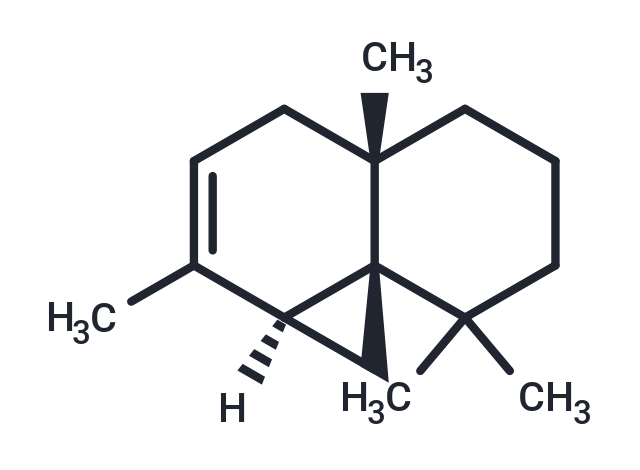- Remove All
 Your shopping cart is currently empty
Your shopping cart is currently empty
Thujopsene
Thujopsene, a sesquiterpene found in T. dolabrata, exhibits a wide range of biological activities. It inhibits Na+/K+-ATPase and cytochrome P450 (CYP) isoform CYP2B6 with IC50 values of 25.9 µg/ml and Ki of 0.8 µM, respectively. Additionally, thujopsene demonstrates antimicrobial efficacy against both Gram-positive and Gram-negative bacteria, such as S. aureus, M. luteus, and S. typhimurium, with MICs ranging from 25-50 µg/ml. It also suppresses antigen-induced β-hexosaminidase release in IgE-sensitized RBL-2H3 mast cells (IC50= 25.1 µM) and shows cytotoxicity against A549 non-small cell lung cancer cells with an LC50 of 35.27 µg/ml. Furthermore, thujopsene causes mortality in mites D. farinae and T. putrescentiae, with LC50s of 9.82 and 10.92 µg/cm2, respectively.

Thujopsene
| Pack Size | Price | Availability | Quantity |
|---|---|---|---|
| 10 mg | Inquiry | Backorder | |
| 50 mg | Inquiry | Backorder |
Product Introduction
| Description | Thujopsene, a sesquiterpene found in T. dolabrata, exhibits a wide range of biological activities. It inhibits Na+/K+-ATPase and cytochrome P450 (CYP) isoform CYP2B6 with IC50 values of 25.9 µg/ml and Ki of 0.8 µM, respectively. Additionally, thujopsene demonstrates antimicrobial efficacy against both Gram-positive and Gram-negative bacteria, such as S. aureus, M. luteus, and S. typhimurium, with MICs ranging from 25-50 µg/ml. It also suppresses antigen-induced β-hexosaminidase release in IgE-sensitized RBL-2H3 mast cells (IC50= 25.1 µM) and shows cytotoxicity against A549 non-small cell lung cancer cells with an LC50 of 35.27 µg/ml. Furthermore, thujopsene causes mortality in mites D. farinae and T. putrescentiae, with LC50s of 9.82 and 10.92 µg/cm2, respectively. |
| Alias | NSC 44707 |
| Molecular Weight | 204.35 |
| Formula | C15H24 |
| Cas No. | 470-40-6 |
| Storage | Powder: -20°C for 3 years | In solvent: -80°C for 1 year | Shipping with blue ice. |
Calculator
In Vivo Formulation Calculator (Clear solution)
Dose Conversion
Tech Support

Copyright © 2015-2025 TargetMol Chemicals Inc. All Rights Reserved.




